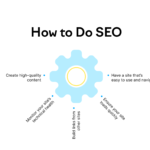Knowing how to define your target market is critical to the success of your business.
In this guide, you’ll learn how to define your target market to create more efficient marketing campaigns to increase conversions and drive better results.
What is a target market?
A target market is a specific group of consumers within an available market that you want to reach with your marketing campaigns. This group of people is highly-interested in your products or services and is more likely to make a purchase than an average consumer.
Members of your target market will have characteristics in common, such as their age, where they live, what they’re interested in, and more.
Why it’s important to accurately define your target market?
Knowing how to define your target market is one of the most important components to the success of your business. If you don’t know who your ideal customers are, you can’t be sure your products or services are meeting their needs.
Furthermore, running efficient marketing campaigns will be next to impossible if you don’t have a clear idea of who your efforts should be focused on.
As Seth Godin once said, “everyone is not your customer”. When you market to everyone you are essentially marketing to no one.
If you target people who are in no way interested in what you’re selling you’ll be wasting your resources to yield little results. This will lead to low conversion rates and higher cost per conversions.
By clearly defining your target audience, your marketing budget will be much more cost-effective as your efforts will be directly focused on the people more likely to purchase from your business.
Your campaigns will be laser-targeted to meet the needs and desires of a specific group resulting in targeted website traffic, more conversions, and overall better results.
Knowing your target audience will allow you to further improve your products or services as you understand the pain points of your customers and what they are looking to solve.
How to define your target market
The best tactics to find your target market are:
- Analyze the profile of your existing customers
- Analyze the profile of your website visitors and social media audience
- Identify who can benefit from your product/service
- Create primary and secondary targets
- Spy on your competition
- Run smart campaigns on Google Ads
- Run paid ads on Facebook
1. Analyze the profile of your existing customers
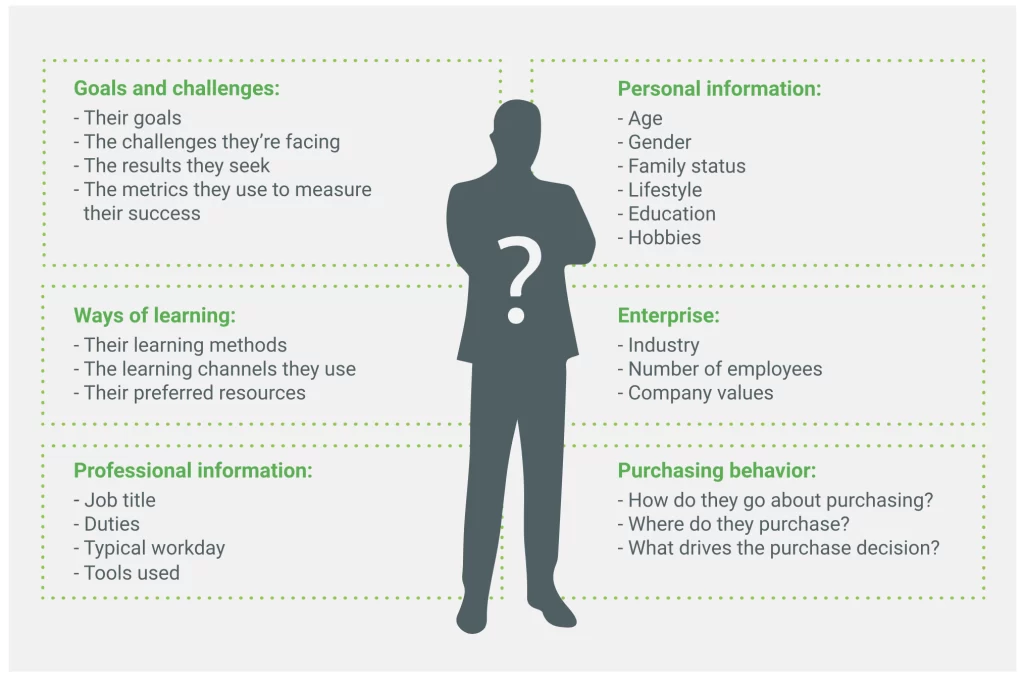
If you already have a customer base, the first step you’ll want to take to define your target audience is to analyze your existing customers.
As these people have already converted into sales, you can gain valuable insights into the type of people that your business is having success with.
Take a close look to see if you can identify any patterns in their characteristics. Some important attributes to evaluate include:
- Age: What is the average age range of your existing customers?
- Location: Where do your customers predominately live? Consider important factors like country, culture, and time zone.
- Gender: Are most of your customers female or male? Knowing this will help you refine your marketing strategy to be more effective.
- Income: What is the average income of your current customers and how much money do they have to spend on your products or services? Do they need to save to purchase from you? Are they able to make repeat purchases?
- Lifestyle: What do your customers do in their free time? What other types of products and services are they interested in?
- Behavior: What kind of brands do your customers interact with online? Which social media platforms are they most active on and what kind of content do they view?
2. Analyze the profile of your website visitors and social media audience
You can gain great insight into the profile of your customers, website visitors, and social media followers by thoroughly reviewing the data on your analytic platforms.
For your website, you likely already use Google Analytics to track your visitors. The free platform from Google provides incredible detail of your website users and all the actions taken on your site.
To be able to collect information about the people visiting your website, you’ll need to enable demographics and interest reports in your Google Analytics settings.
To enable the report:
- Sign in to your Analytics account.
- Open Reports.
- Open the Audience > Demographics > Overview report.
- Click the Enable button
Once enabled you can navigate to different reports in the audience tab to get a more detailed look at your users.
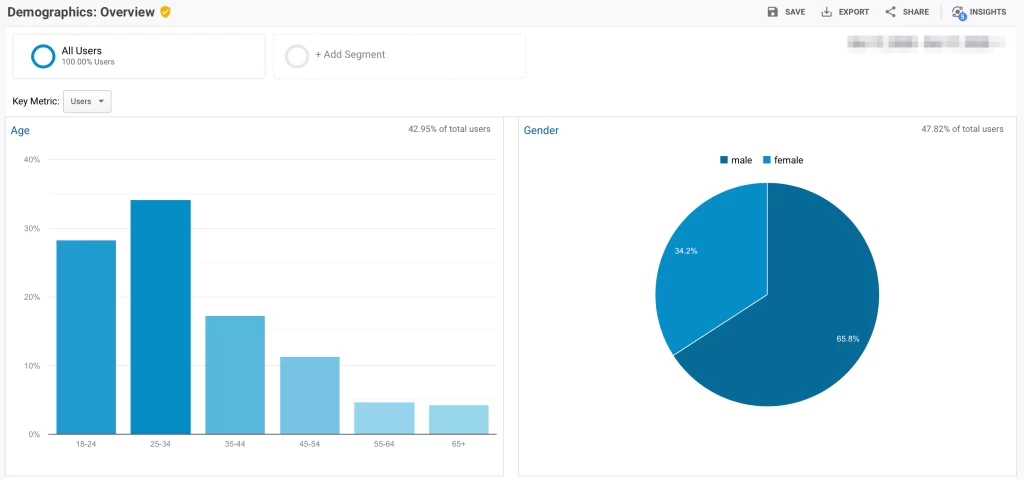
From the demographics report, you’ll be able to see the age and gender of your website visitors along with key metrics for each group including:
- % new sessions
- Average session duration
- Bounce rate
- Pages/Session
- Sessions
- Revenue
- Conversion rate
- And other conversion goals
The Interest Report in Google Analytics will tell you what your users are interested in around the internet. You can find the report under Interests in the Audience tab.
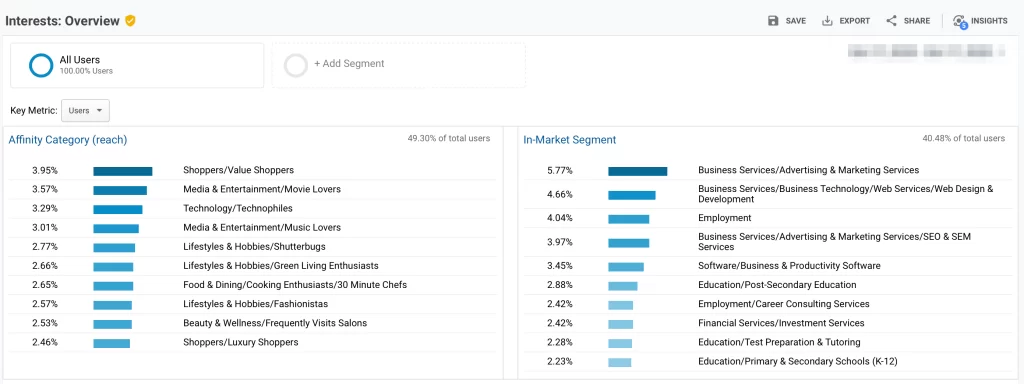
The report is broken into three primary sub-reports:
- Affinity Categories: These are top-level categories, broken into broad interests such as Shoppers, Sports, Technology.
- In-Market Segments: This category includes people who have expressed an interest in buying certain types of products. Some of the product categories include Consumer Electronics, Travel, and Business Services.
- Other Categories: This group represents users who don’t fit into Google’s Affinity and In-Market segments but could be interested in particular areas such as News, Art, and Job Services.
Social media platforms also provide useful analytics you can use to understand your audience better.
One such tool is Instagram which provides detailed information about the age, gender, location of your followers. It also lets you know the best time of the day for engaging with your followers.
Another useful social media tool you can use to learn more about your target audience is Facebook Audience Insights.
You can search by different demographics such as age, gender, and location as well as other attributes such as interests and behaviors. This will help you discover any patterns in demographics or behaviors that you can use to define your target audience.
Audience Insights also provides an estimated size of the target market.
For example, let’s say you want to open a running apparel store in New York. You can select “New York for location, and for “Interests” select “Running.
Audience Insights will automatically populate the data for Facebook users in New York who are interested in running.
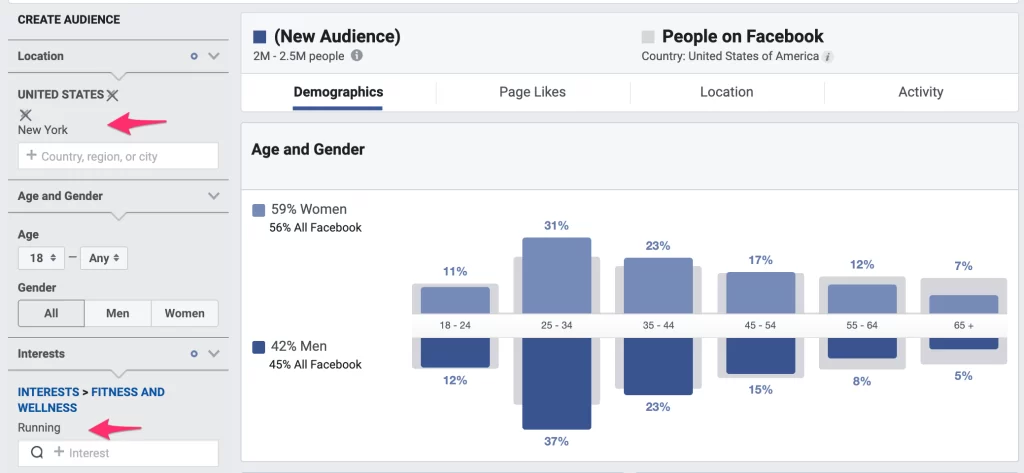
You’ll see that they are predominantly women, at 59%. Most tend to be between 25 and 34 in age. 44% are married and 64% went to college. You can also see an estimate for the total audience size of around 2 million people.
3. Identify who can benefit from your product/service
When you’re defining your target audience it is very important to understand the unique value of your products or services and who can benefit from them the most.
To start, you need to distinguish between your product’s features and its benefits.
Rather than focusing solely on what you do and how you do it, closely analyze your products and services to see how they are of value to customers.
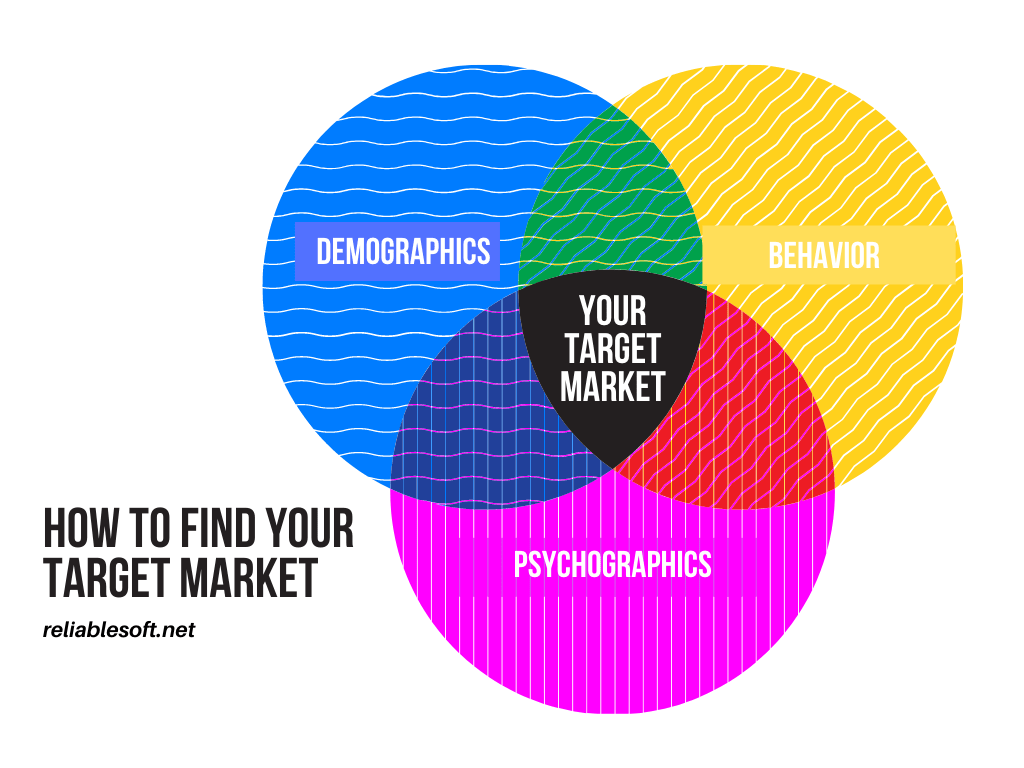
Ask yourself: What problem are you trying to solve? What desires do you want to fulfill? How does your product or service meet these needs?
Customers who will benefit from your business the most will share similar characteristics. When evaluating who has the most to gain from your products or services, consider the following traits:
- Demographics: Target customers are characterized by different criteria such as age, gender, ethnicity, religion, income level, education, and more. Look for a pattern between these characteristics.
- Geographics: Geographics refers to where your target audience lives. Your products or services will only be relevant to people in a certain area. This could be a local, state, national, or international market, depending on what your business offers. Knowing the geographic characteristics of the people who will benefit from your products will help your form appropriate marketing campaigns.
- Behavioristic: Behavioristic characteristics focus on how people act including purchasing and spending habits, brand interactions, and customer loyalty. This data is used to understand what it is that motivates people to purchase from your business.
- Psychographics: Psychographics categorizes people based on factors related to their personalities such as interests, attitudes values, and beliefs. These characteristics will play a major role in a person’s shopping behavior. For example, someone who purchases luxury items may do so because they value quality and status.
Knowing this information will allow you to create detailed customer profiles for the different groups of people that can benefit from what your business offers.
4. Create primary and secondary targets
You can segment your target audience even more by defining primary and secondary targets.
Your primary target audience is the main focus of your business and represents the group of customers with the greatest value to your business. This value can be the result of them having the greatest possibility of converting or having a higher average order value.
Many products and services will fulfill the needs of a variety of different groups of people. What makes your primary target audience distinct is that this group has the greatest need for your products or service, the ability to pay for them, and gains the most benefits.
They will live in the same geographic region as your business and will likely make up the bulk of your sales.
The primary target audience won’t necessarily be the largest group in your market but it is vital to the success of your business.
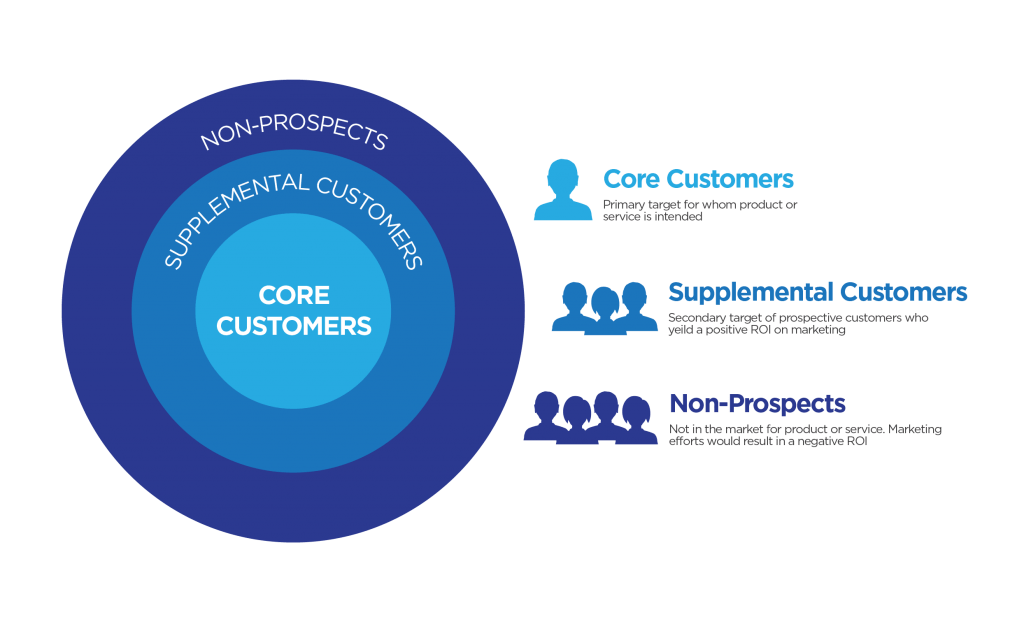
Secondary target audiences work as a complement to your primary targets. They are other groups of people with a strong interest in your products or services.
Secondary target audiences can share characteristics with your primary audience while having unique attributes of their own.
These groups are less valuable to your business as they often have:
- Less money to spend on your products or services
- Lower demand for what you offer
- Too small in number and monetary value to constitute a primary target
5. Spy on your competition
Checking your competition is an effective way to understand your target customer.
Identify your main competitors and take a look at their website, social media profiles, and search ads and try to discern who their target audience is.
You can get a true idea of their customer experience by signing up for their newsletter, following their social media pages, or even buying their products.
There are two more ways to effectively spy on your competitors and find their target market.
The first way is to use a digital marketing platform like SEMRush. These platforms have dedicated tools for analyzing your competitor’s audience.
For example with SEMRush Traffic Analysis tool, you can find out in detail from where your competitors get traffic, what are the main characteristics of its audience, which social networks do they use, and a lot of other information that will help you build your audience personas.
You can also automatically compare the characteristics of your audience with their own and identify audience gaps to add to your primary and secondary targets.
The second way to learn from your competitors is to use the Facebook Ad Library.
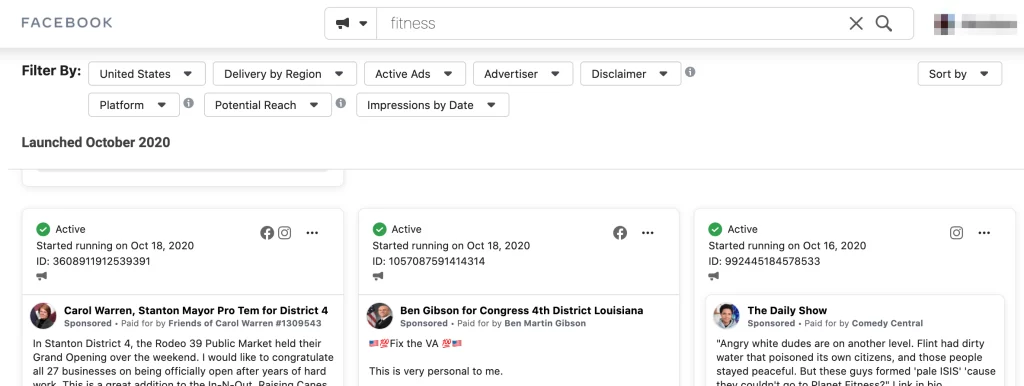
The Ad Library is a database of ads running on Facebook and all its properties such as Instagram.
This allows you to view the ads to see the imagery and messaging your competitors are using to reach potential customers. You can filter the results by active/inactive, country, region, platform, and audience size.
You can search the library by using a competitor’s name or keyword.
6. Run smart campaigns on Google Ads
Another way to find your target market is to run test ads. With this strategy, you can set up and run a marketing campaign with a generalized audience.
You can then use the data from the campaign to see which groups of people were the most interested in your business and use these insights to form your target audience.
Google is a great platform for running test campaigns as they offer a variety of data-driven targeting methods that will improve the efficiency of finding the best audience.
You can start by using Smart Campaigns, which will automate audience targeting based on the product or service being advertised and the goal you set.
To set up your Smart campaign, you’ll create an ad that describes your business, choose the keywords you want to target, and set your ad budget.
Your ad will then automatically show to people across Google’s properties including Search, Maps, Gmail, Youtube, and partner websites.
Smart campaigns use machine learning to maximize conversion in every ad auction. They look at data signals from performance history to begin to refine the ad targeting to reach the most relevant individuals.
Over time, Google will have narrowed in on the most effective audience for the campaign. You can then use the information to identify the characteristics of the people most interested in your campaign to define your target market.
Another way to use Google to help define your target audience for you is to use Discovery Ads.
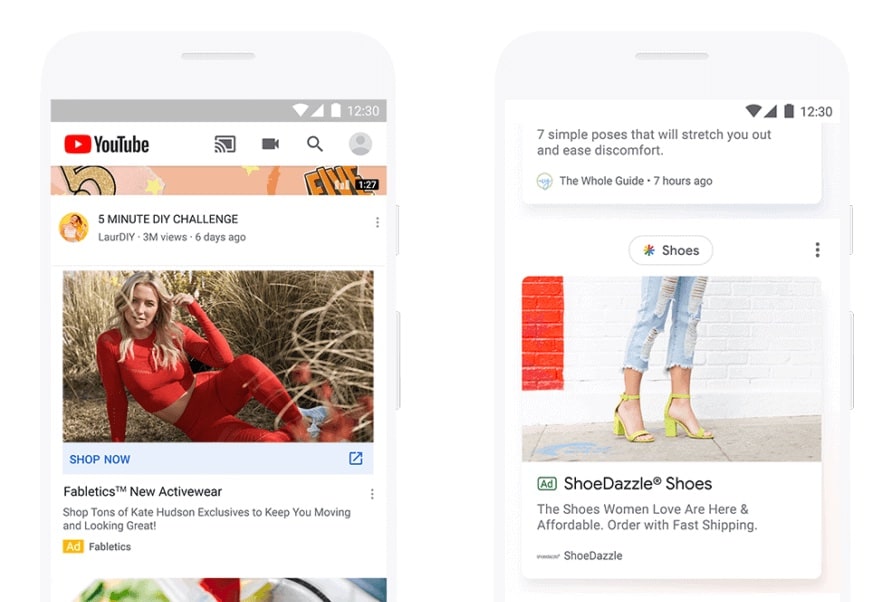
Discovery Ads are a visual ad format that runs across the Google Discover Feed, shown on the homepage of the Google app and mobile site, Gmail, and Youtube home feed.
The ads focus on visually-rich experiences and the format varies based on which of these properties they are being shown.
When you set up your Discovery ads, you’ll provide one landing page URL, an image, a logo, and up to five headlines and descriptions.
Google will then use machine learning to serve the best performing combinations of the above variables.
Like Smart campaigns, Google is looking to automate the ad optimization process to help businesses target the most relevant people with their ads.
7. Run paid ads on Facebook
You can use a similar advertising tactic on Facebook to discover the characteristics of your target customers.
Start by creating a marketing campaign with a general audience and let the campaign run until you have enough data to gain meaningful insights from the results.
The Facebook Ads Manager provides a variety of metrics you can use to help you gain a deep understanding of your campaign’s performance.
You can get a more detailed understanding by using the Breakdown menu. This will allow you to filter your campaign reports based on:
- Delivery: See more information about who your ad was delivered to. Filter using criteria such as age, gender, location, browsing platform, platform, device, time of day, and others.
- Action: See more information on the actions taken as a result of your ad. This includes conversion device, destination, video view type, video sound, carousel card, and others.
- Time: Detail by day, week, two-week periods, and months.
The data provided by breakdowns will give you clear insight into which groups of people are responding the best to your marketing campaigns. You can then use this knowledge to find your target market.
Target market examples
Let’s take a look at some examples of target markets for different types of businesses.
1. Athleisure brand

Primary audience – Women looking for stylish yet comfortable clothing to wear for a variety of occasions.
Secondary audience – Men and women looking for modern looking clothing to exercise in.
Demographics
- Age range: 18-34
- Gender: 70% female, 30% male
Psychographics
- Looks up to lifestyle and fitness influencers.
- Loyal to one or two clothing brands.
- Values the status of wearing premium apparel
Geographic
- Major cities in the United States
- Suburbs of major cities in the United States.
Preferred channels
- Follows health and wellness influencers on Instagram.
- Reads health and wellness blogs for exercise tips
2. Vegan Protein Powder

Primary audience – People who are health conscious and follow a strict vegan diet that is looking for protein powder.
Secondary audience – People who are looking for a protein powder and want an alternative type of protein to complement a diet heavy in meat.
Demographics
- Age range: 18-34.
- Gender: 55% female, 45% male.
Psychographics
- Tries to eat a diet that is sustainable, filled with organic and non-GMO foods
- Likes to take hikes and explore nature
- Loyal to brands that share their values
Geographic
- Major cities in the United States
- Suburbs of major cities in the United States
Preferred channels
- Reads blog posts about holistic living
- Watches nutrition videos from health influencers on Youtube
- Follows nature accounts on Instagram.
3. SaaS Marketing Solution

Primary audience – Marketing professionals looking to automate their business processes to improve efficiency and drive better results.
Secondary audience – Solo entrepreneurs looking for a marketing solution that provides extensive functionality in a single service.
Key demographics
- Age range: 35-49.
- Gender: 60% male, 40% female.
- Income Level: $80,000/year or higher
Psychographics
- Likes to review and compare products before making a decision
- Wants to prove competency in their profession
- Hesitant to try new methods of doing things
Geographic
- Major cities in the United States
- Suburbs of major cities in the United States
Preferred Channels
- Email is the go-to medium for communication
- Uses social media platforms such as LinkedIn and Twitter for networking and industry insights.
Key Learnings
The target market definition is a specific group of people that your business wants to reach with its products or services.
This group of people is the most valuable to your business because they are the most interested in your product and represent the highest chance of a conversion.
Without knowing your target audience, running effective marketing campaigns is extremely difficult. If you target people who are not interested in your business or do not have the money to buy from you, you will waste your budget on campaigns with low conversion rates and higher cost per acquisition.
Defining your target audience allows you to pinpoint the ideal customer for your business so you can direct your efforts to them as they are the ones that will drive results.
The first step to target marketing is to analyze your existing customers. These people have already bought from you so you can look for common characteristics between them to establish a baseline for the type of people you want to target.
Next, you can analyze your website and social media profiles to see who is interacting with your business. Look at your analytics platform for each channel to find important demographic, geographic, and psychographic information that you can use to create profiles of your target customer.
Review the unique value of your business and the benefits of your products. Use this information to determine which people could benefit the most from buying from.
When you start to better understand the characteristics of your target customers you can create primary and secondary audiences. This will allow you to segment your customer base even more, to provide highly relevant messaging to each group.
Looking at the competition can provide helpful insights into ideal customers in your industry.
Finally, you can define your target audience by running test campaigns on platforms such as Google and Facebook. You can start with a general audience and then analyze the results to see which groups of people responded the best and use them to create a target audience.
Establishing your target market takes effort, but it is essential to the continued success of your business.

